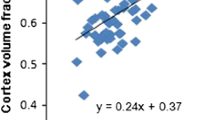Summary
Firstly details are collected concerning the required parameters of a simple linear regression in order to evaluate statistically results of measurements, which can also be present in the form (x i ,y i ±SD i ). In this way lines of regression are determined for connections between the kidney weight and the body weight, between the lengths of the proximal tubules (and the proximal convolution) of the three various types of nephron and the kidney weight, between the length of the distal convoluted tubule, likewise the number of glomerula, and the kidney weight and finally between the single nephron filtration rate and the length of the proximal tubule.
Starting from a model body weight for the rat of 200 g and considering the percentage of thin segments in the tissue of the renal pyramid, a loop of Henle with a length of 8.1 mm for the thin part and a length of 2.4 mm for the ascending thick limb was calculated for the model nephron from the lengths of the loops of the three types of nephrons. In contrast to former model formulations concerning the collecting duct system, the tree-like branched structure was considered for the first time and a linear approximation to the relation between both the circumference line and the cross section area and the length of the collecting ducts was determined.
The geometric model relates only to the tubular system and takes no notice of the blood vessels.
Zusammenfassung
Es werden zunächst Angaben über die notwendigen Parameter einer einfachen linearen Regression zusammengestellt, um Meßergebnisse, die auch in der Form (x i ,y i ±SD i ) vorliegen können, statistisch auszuwerten. Damit werden Regressionsgeraden ermittelt für Zusammenhänge zwischen Nieren- und Körpergewicht, zwischen den Längen der proximalen Tubuli (und des proximalen Konvoluts) der drei verschiedenen Nephrentypen und dem Nierengewicht, zwischen der Länge des distalen Konvoluts sowie der Zahl der Glomerula und dem Nierengewicht und schließlich zwischen der Einzelnephronfiltrationsrate und der Länge des proximalen Tubulus.
Ausgehend von einem Modellkörpergewicht der Ratte von 200 g ergab sich unter Berücksichtigung des prozentualen Volumenanteils der dünnen Segmente am gesamten Markgewebe aus den Schleifenlängen der drei Nephrentypen für das Modellnephron eine Henle-Schleife, deren dünner Teil 8,1 mm und deren dicker aufsteigender Ast 2,4 mm lang ist.
Beim Sammelrohrsystem wurde erstmals gegenüber bisherigen Modellansätzen die baumartig verzweigte Struktur berücksichtigt und sowohl für die Umfangslinie wie auch für die Querschnittsfläche ein linearer Zusammenhang mit der Länge der Sammelrohre erarbeitet.
Das geometrische Modell bezieht sich nur auf das tubuläre System ohne Berücksichtigung der Blutgefäße.
Similar content being viewed by others
References
Baines, A. D., Baines, C. J., Rouffignac, C. de: Functional heterogeneity of nephrons I. Arch. Ges. Physiol.308, 244–259 (1969a)
Baines, A. D., Rouffignac, C. de, Deiss, S.: Functional heterogeneity of nephrons II. Arch. Ges. Physiol.308, 260–276 (1969b)
Blume, J.: Statistische Methoden für Ingenieure und Naturwissenschaftler, Bd. I, S. 51 ff. Düsseldorf: VDI-Verlag 1970
Böse, H.: Einführung in die Ausgleichsrechnung, S. 59ff. München: Oldenbourg 1965
Heinhold, J., Gaede, K. W.: Ingenieur-Statistik, S. 229ff. München: Oldenbourg 1972
Hülsen, B.: Außen- und Innendurchmesser der einzelnen Abschnitte der Henleschen Schleife der Rattenniere in Antidiurese. Inaugural-Disseration, Westfälische Wilhelms-Universität Münster, 1973
Koepsell, H., Kriz, W., Schnermann, J.: Pattern of luminal diameter changes along the descending and ascending thin limbs of the loop of Henle in the inner medullary zone of the rat kidney. Z. Anat. Entwickl.-Gesch.138, 321–328 (1972)
Kriz, W.: Der architektonische und funktionelle Aufbau der Rattenniere. Z. Zellforsch.82, 495–535 (1967)
Kriz, W., Schnermann, J., Koepsell, H.: The position of short and long loops of Henle in the rat kidney. Z. Anat. Entwickl.-Gesch.138, 301–319 (1972)
Munkácsi, I., Palkovits, M.: Study on the renal pyramid, loops of Henle and percentage distribution of their thin segments in mammals living in desert, semidesert and water-rich environment. Acta biol. Acad. Sci. hung.17, 89–104 (1966)
Oliver, J.: Nephrons and kidneys. New York: Hoeber Medical Division 1968
Rouffignac, C. de, Bonvalet, J. P.: Étude chez le rat des variations du débit individuel de filtration glomérulaire des néphrons superficiels et profonds en fonction de l'apport sodé. Arch. Ges. Physiol.315, 141–156 (1970a)
Rouffignac, C. de, Deiss, S., Bonvalet, J. P.: Détermination du taux individuel de filtration glomérulaire des néphrons accessibles et inaccessibles à la microponction. Arch. Ges. Physiol.315, 273–290 (1970b)
Rouffignac, C. de, Morel, F.: Étude par microdissection de la distribution et de la longueur des tubules proximaux dans le rein de cinq espèces de rongueurs. Arch. Anat. micr. Morph. exp.56, 123–132 (1967)
Sperber, I.: Studies on the mammalian kidney. Zool. Bidrag. (Uppsala)22, 249–431 (1944)
Ullrich, K. J.: Das Nierenmark. Struktur, Stoffwechsel und Funktion. Ergebn. Physiol.50, 433–489 (1959)
Ullrich, K. J., Kramer, K., Boylan, J. W.: Present knowledge of the counter-currant system in the mammalian kidney. In: Heart, kidney and electrolytes. Hrsg. von Ch. K. Friedberg, p. 1–37. New York: Grune & Stratton 1962
Wahl, M., Schnermann, J.: Microdissection study of the length of the different tubular segments of rat superficial nephrons. Z. Anat. Entwickl.-Gesch.129, 128–134 (1969)
Author information
Authors and Affiliations
Additional information
Direktor: Prof. Dr.-Ing. E. D. Gilles
This work was supported by the Deutsche Forschungsgemeinschaft.
Rights and permissions
About this article
Cite this article
Kainer, R. A geometric model of the rat kidney. Anat. Embryol. 147, 91–109 (1974). https://doi.org/10.1007/BF00317966
Received:
Issue Date:
DOI: https://doi.org/10.1007/BF00317966




